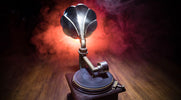
History of the record player
, by Haim Deutsch, 3 min reading time

, by Haim Deutsch, 3 min reading time
Beginnings
The history of the turntable like the one in your home or the one you are about to buy goes back only around 70 years. However, it’s technological and theoretical history stretches back to 1857.
That year was the year that Édouard-Léon Scott de Martinville showcased the phonautograph, which used a vibrating diaphragm and stylus to record sound waves by tracing them onto paper. It did not, however, produce any sound. That was left to Thomas Edison, inventor of the phonograph in 1877.
Edison’s invention consisted of a tin foiled wrapped grooved cylinder, which could be turned by a crank. When sound was entered into the mouthpiece, the sound waves made the diaphragm and needle vibrate, making indentations in the foil, which was soon swapped for wax.
The forefather of the turntable, Edison's phonograph initially comprised a grooved cylinder wrapped in tin foil (the recording surface) that could be turned by a hand crank. When sound was entered into the mouthpiece, the sound waves made the diaphragm and attached needle vibrate, making indentations in the foil. Edison soon swapped out tinfoil for wax for its better sound and improved durability.
Into the next century, these discs were being mass produced, and the design was tweaked to make it functional in the home. The discs became known as records.
While the horn necessary to amplify the sound was initially large, it was altered by US phonograph and record brand Victor Talking Machine Company to tilt down so the whole device could fit in a cabinet. The device’s name: Victrola.
Electronically powered players were starting to replace wind-up players in the 1930s. There was a stint of popularity for turntable systems that had amplification and speakers built into them, before the dedicated hi-fi record player began to take prominence.
RCA Victor, founded in 1929, had begun selling the Duo Jr, a turntable that was designed to be plugged into radio sets, negating the need for a phonograph’s bulky built-in system.
Idler wheel, belt-drive, direct-drive
The turntable that you own or that you will buy will be a belt-drive system or a direct-drive system. The first record players were idler wheel designs.
Initially, stereo turntables were record changers that could play many records in a row. Stacked on a spindle, the records would be automatically spun, finished, and then another would be put on and spun. The idler wheel - a rubber wheel that ran off the motor and sat underneath the platter, able to protect the platter from vibrations and making playback as good as possible - was the ideal system.
This method could not effectively continue when the wheel was coupled to the motor. The belt drive was a much more efficient system, as a motor off to the side of the turntable drove a rubber belt that wrapped around the outside of the platter to turn it. The direct-drive was invented in the early ‘70s by Panasonic's Technics brand. In this method, the platter sits on top of a drive motor that spins at 33 1/3 or 45 RPM. Unlike the idler wheel and belt-drive designs, there shouldn't be anything to replace or repair, with no belts and no wheels. The drawback was cost, which is why you'll tend to only find direct-drive decks on higher-end turntables.
Revival
The 1970s were the golden era for all things vinyl, seen in artists adapting their concepts to maximise the potential of the long-form vinyl format. But all good things come to an end, and with the popularity of cassettes, followed by CDs in the 1980s, vinyl quickly became considered a thing of the past.
But you can't keep a good thing down. And the much-discussed vinyl revival has seen an unprecedented resurgence in the aged format, as young and old music fans discover the beauty of physical media and the enjoyment to be had in taking the time to sit back and listen to a piece of music (and then get up and turn it over).
Modern turntables are kaleidoscopic in their variety - from built-in phono, to Bluetooth, to Spotify connectivity, retro stylings and ultra-modern technology.